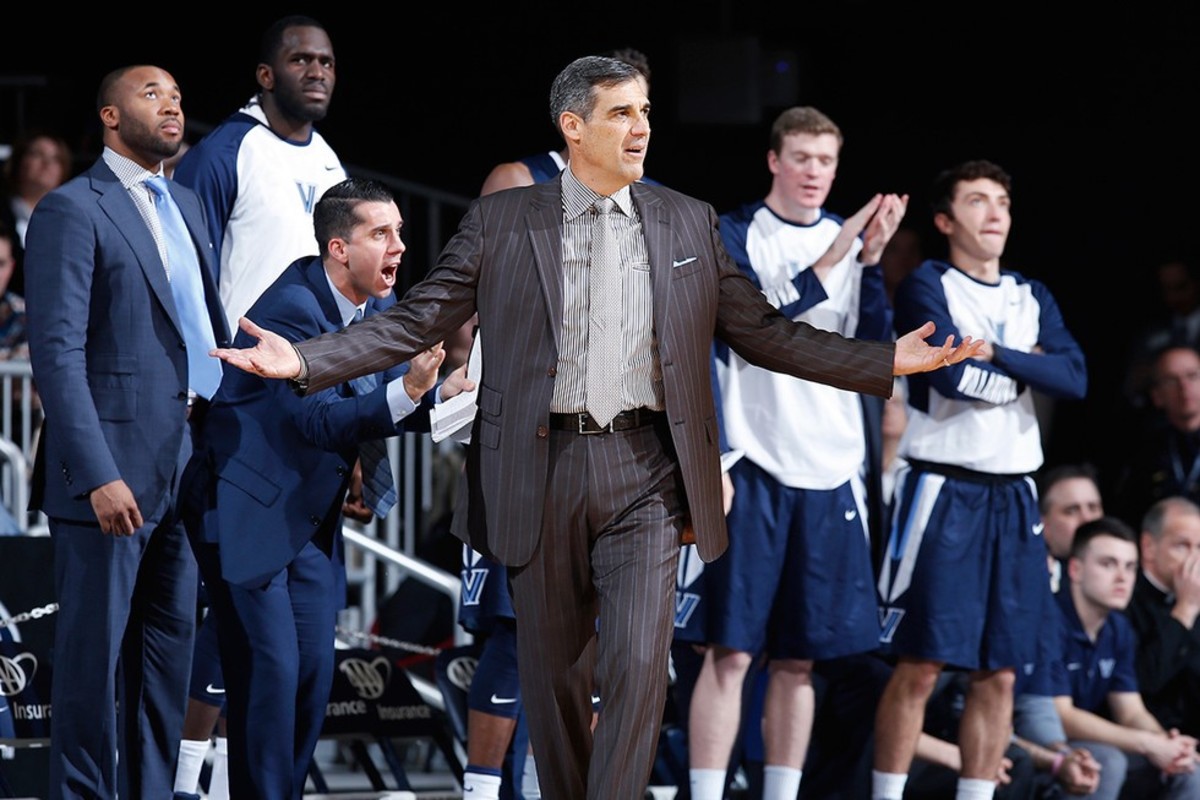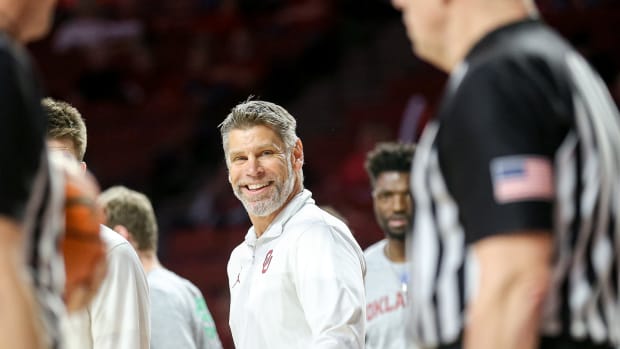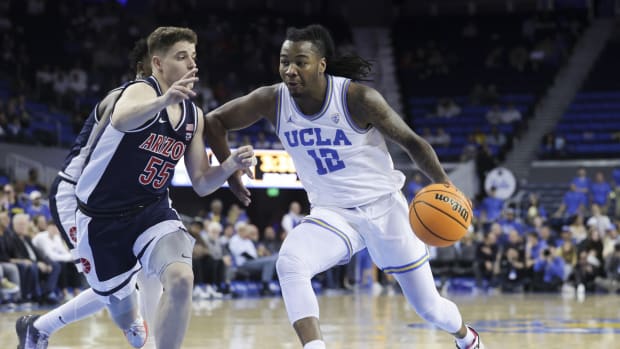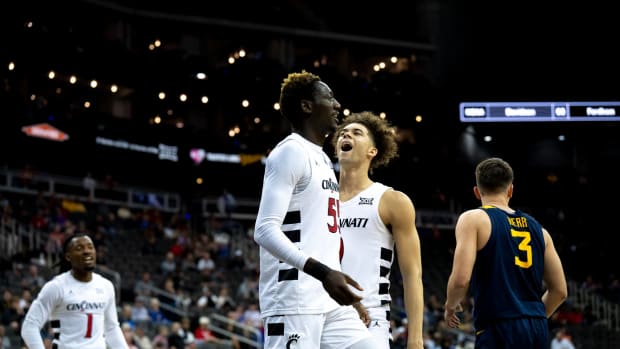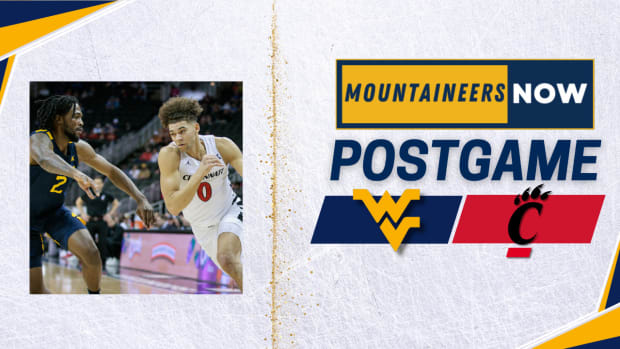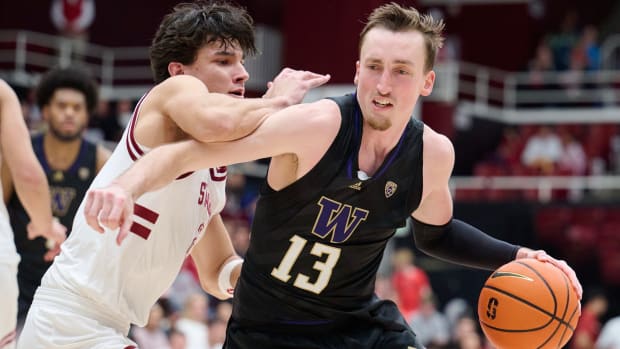Jay Wright and Villanova believe they've found the perfect balance for a deep NCAA tournament run
As he walked down a hallway in Milwaukee's Bradley Center late Saturday afternoon following an 89–79 win over Marquette, Jay Wright encountered a tall kid with a smiling face, coming from the opposite direction. Michael Massimino had caught Villanova's coach by surprise, but Wright eagerly extended a hand. "'Mass'!" he exclaimed. "I forgot you were here! Great to see you!" Michael, the grandson of former Wildcats coach Rollie Massimino, returned the handshake and Wright kept moving. But it figured: Around every corner, there's some reminder about what the No. 3 Wildcats are expected to accomplish March.
The elder Massimino famously guided the Wildcats to the national title in 1985, knocking off defending champion Patrick Ewing and Georgetown in the championship game. Almost a quarter-century later, Wright returned Villanova to the Final Four where it lost in 2009 to eventual champion North Carolina. Since, the Wildcats have not once escaped the first weekend of the NCAA tournament, losing five times as the higher seed—including twice as a No. 2 and last year, in the Round of 32, as a No. 1. So, naturally, a conversation with Villanova's coach revolves around this year's version of the plan, and most importantly, whether or not it will work.
"I think it's a team that could have perfect balance," Wright said outside the visitors' locker room, somewhat quietly, like he was telling a secret, "and what's what we're striving for."
Though the Wildcats are perceived as a three-point reliant team, they may be able to challenge those presumptions this postseason. And there's actually nothing clandestine about the plan. While the three-pointer remains a necessary component to the Wildcats' offensive philosophy, this team has multiple viable options in the post plus guards and wings adept at penetration, even more so than last season's 33–3 club. And that may allow Villanova to withstand any shortfalls from long range, which can undercut a postseason run quickly.
Villanova is shooting 33.0% from three-point range going into a Tuesday meeting with DePaul, ranking 252nd in the country. That's not good. What is good: Shooting 57.1% on two-pointers, ranking in the 91st percentile in points per post-up possession (0.96) and the 99th percentile in points per possession on other around-the-basket attempts (1.301). Villanova might not have to make threes at an exceptionally high rate to thrive. "Whenever we have our threes, we take those," junior forward Kris Jenkins said. "We always look to catch and shoot. When teams take it away, we're basketball players, so we all know we can make the right play. If the right play is to drive and not shoot a three, that's what we do. That's why our teams have been good for each other."
When a team is not proficient at connecting on long-range attempts, it might be advised to stop hoisting so many of them. (Surely some Villanova fans watching the 9-of-28 three-point shooting in that Round of 32 loss to N.C. State last year went hoarse shouting this.) But during nonconference play this season, a staggering 48.6% of Villanova's shots were three-pointers. Wright attributed that to three new backcourt/wing starters—juniors Jenkins and Josh Hart, as well as freshman guard Jalen Brunson—and the coaching staff's preference that they play hyper-aggressively early before toning it down later. "So all the new guys were just firing," Wright said.
Gradually, the approach matured. Villanova's three-point shooting volume has dropped to 41.1% in Big East games, bringing the overall volume number to 42.9%. The adjustment suggests the Wildcats recognize their strengths and how to benefit from them. "We have a great two-point field goal percentage because everybody knows we'll take those threes," Wright said. "And they know we could make them. They don't fear them a lot, but they know we could. And the fear of making them makes you guard them. We get to the rim in space because people stay with our three-point shooters."
Wright chalks up the low three-point percentage mostly to poor shot selection while he and his staff allowed those new starters to find their spots. He otherwise shrugs it off. He recalls playing Penn on Dec. 28 and Quakers coach Steve Donahue game-planning to hug up on the three-point line and never leave shooters; the Wildcats scored the first 14 points, all on two-pointers or free throws and won 77–57 anyway. But it was instructive in how significant a threat the shot is for Villanova—and, even when it is removed from the equation, how resourceful Wright's team can be.
Porter Binks/Getty
If he's seeking perfect balance, Wright may have an ideal roster for the hunt. Hart, at 6'5", has the length to finish in a cluttered lane; per Synergy Sports Data, he's at 1.112 points per possession on drives, including 1.155 when he goes left (which is good for the 94th percentile nationally). The sturdy 6'6", 240-pound Jenkins is at 1.062 points per possession on post-ups (91st percentile nationally) and 1.000 on drives. (They're the team's top two scorers at 15.1 and 11.9 points per game, respectively.)
Even freshman guard Jalen Brunson, at 6'3", is a fearless lane crasher with the strength to complete the play; he's shooting 52.5% from two-point range and is at a solid 0.954 points per possession on drives. Meanwhile, 6'11" center Daniel Ochefu's 10.7 points per game are a career-best, and he's scored in double-figures in four of six outings since a three-game absence due to a concussion suffered during a practice in late January.
In sum, this does not revolutionize how Villanova operates. But set the numbers from last year and this year side-to-side, and the current batch of Wildcats indeed appears to have a greater capacity to attack effectively:
* 2014–15 season: 52.9% two-point shooting, 38.9% three-point shooting, 1.172 points per possession around the basket (79th percentile nationally).
* 2015–16 season: 59.1% two-point shooting, 33% three-point shooting, 1.301 points per possession around the basket (99th percentile nationally).
It's a good argument against the Wildcats settling for anything but the best beyond-the-arc looks. Consider some of the game-turning moments against Marquette: After the Golden Eagles' got within six early in the second half, Hart scored twice at the rim, followed by an Ochefu bucket off a post isolation, and the Wildcats' lead doubled in a blink. Later, when Marquette's Wally Ellenson hit consecutive three-pointers to cut the deficit to 79–68, Wright called timeout with 3:55 left and ran a play through Ochefu out of the break. The center hit a cutting Hart for a layup to quell the comeback attempt. "We need to use him," Wright said of Ochefu, whose 18-point, 12-rebound effort was his first double-double since Jan. 6. "We really do. He's a force."
On the very next offensive trip following that Ochefu-Hart connection, Jenkins launched a three-pointer early in the shot clock instead of working the ball around and draining the clock with a 13-point lead. It missed, and it reinforced the point: Villanova is better off driving before all else.
"We're trying to get to where we feel like if they're taking away threes, we can get to the rim," Wright said. "If they're really good guarding us one on one, we can put it in the post and play out of the post. That's what we're striving for. We're not a finished product."
But then Villanova seems to be a lot of things. It seems to be willing to pursue points at the rim, and that would seem to be insurance against a fateful drought from long distance in the NCAA tournament. It seems to have the requisite defensive chops, ranking sixth nationally in adjusted efficiency. It seems to be legitimately among the best bets in a year where nothing is guaranteed, losing only to fellow national title contenders Oklahoma, Virginia and Xavier on the road and also dropping an overtime contest at then-No. 16 Providence at the Wells Fargo Center on Jan. 24.
It seems like Villanova should feel good about its chances. But it felt good about its chances last year, too, as a No. 1 seed with a lineup full of experience. "We knew where we were," Wright said of that club, and everyone knows where they ended up. So it's on to another March and another NCAA tournament and another plan to emerge from the first weekend intact. A plan for perfect balance is as sound as any. And close to perfect might work, too.
